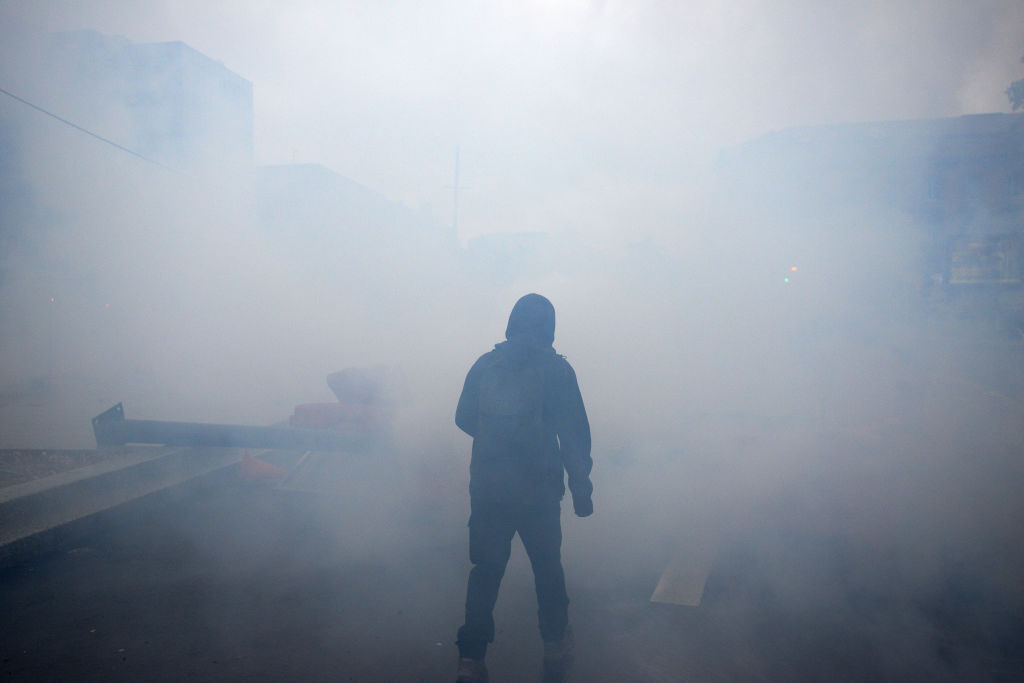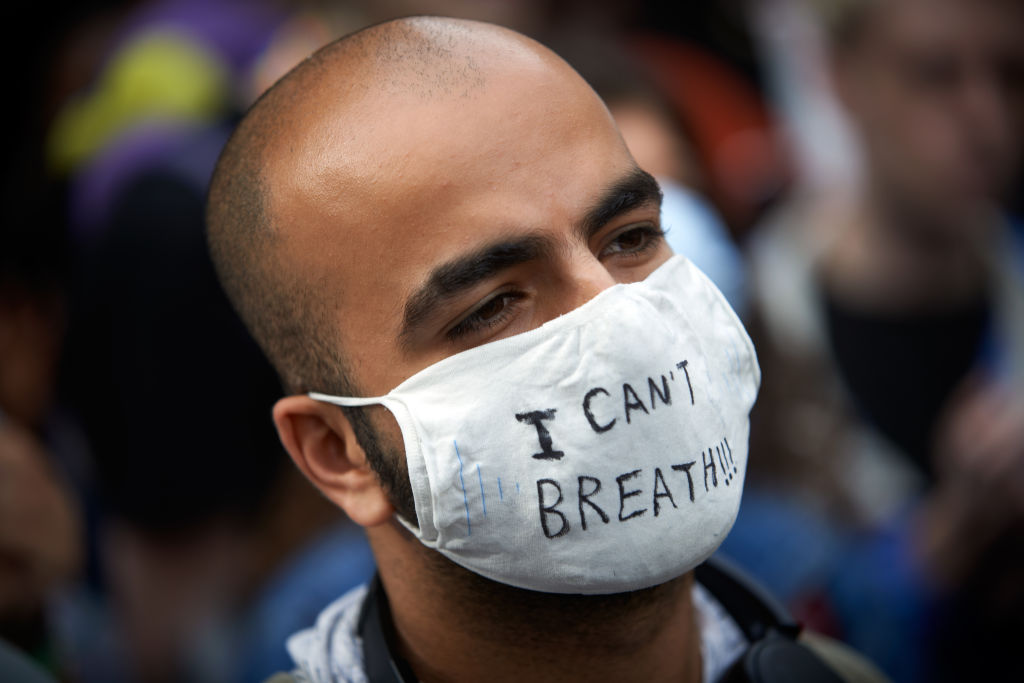
Cal Anderson Park is a large green space in Seattle. It’s where many of the city’s Capitol Hill residents have been going to get fresh air and exercise during coronavirus social-distancing measures. For several nights in early June, it was filled with tear gas instead, as police attempted to disperse crowds who were protesting the killing of George Floyd.
Police in Detroit, Los Angeles, San Antonio, Philadelphia, and Dallas have also used tear gas or pepper spray, hitting protesters with fogs or streams of chemical irritants that leave them tearing up and gasping for breath.
“They start feeling asphyxiated and try to run away from the source of the tear gas agent, so that is the whole intent of using, deploying this tear gas,” Dr. Satya Achanta, assistant professor in the department of anesthesiology at the Duke University School of Medicine, told Digital Trends.
As protests continue to spread across the U.S. and beyond, here’s what you need to know about tear gas.
What is tear gas, chemically speaking?
Police and armies have used tear gas since before the first world war. The chemicals used to induce watery eyes, runny noses, and respiratory inflammation have changed in the last 100 years, but 2-chlorobenzalmalononitrile, known as CS, has been around nearly that long. It wasn’t widely used until the mid-1900s, but now it’s one of the most common crowd-control chemicals in the United States.
CS is solid at room temperature and is often mixed with a solvent like methyl isobutyl ketone. The concoction is aerosolized as a cloud when someone deploys the canister or grenade. “For the pyrotechnic composition, they use a combination of several other compounds, and again, most of the other ingredients are also toxic,” said Achanta.

Pepper spray (also known as oleoresin capsicum or OC) is chemically different from CS, but it produces similar effects. As its name suggests, it’s made from the same compounds found in chili peppers, including capsaicin. Originally meant as an animal control device — mail carriers have used it against dogs — police departments started utilizing pepper spray in the 1980s and ’90s. It’s usually found in spray form and deployed from handheld canisters. The concentration of pepper spray can vary, with less potent versions available for purchase by the general public.
How does tear gas work?
Nerve endings in our eyes, noses, skin, and respiratory systems help detect environmental irritants. CS interacts with these nerve receptors, including what’s known as the TRPA1 ion channels. When the ion channels are activated, it kicks off an inflammatory response, meant to expel the irritant, through a flood of tears and mucus.
“So, when somebody’s exposed, the first thing, our eyes, they are so sensitive and highly innervated, so they start tearing,” said Achanta. A person start blinking involuntarily, and their eyes will burn. “Then simultaneously, because they’re also inhaling, they start feeling a burning sensation with their nose, and there will be lots of nasal secretions,” he said. “Then victims feel as if they are choking, and they feel chest tightness and also they feel as if they are being asphyxiated.” People may start coughing or choking as the chemical enters the respiratory tract. It can cause the skin to itch, sting, and turn red.
How do you treat someone exposed to tear gas?
Achanta said that in videos of protests where police use tear gas, you may see a cloud stay low on the ground, while another rises into the air. The heavy particles of CS fall on the ground, while the other compounds, which are lighter, stay aloft. That’s why he recommends the first thing people should do when exposed is move away from the gas and toward higher ground.
You’ll also want to quickly remove and throw away contact lenses. (It’s not recommended you wear them if there’s a potential you’ll come into contact with tear gas or pepper spray.) You should also remove your glasses; those you can keep, but you should wash them with soap and water before putting them back on.

Achanta said to flush the eyes with fresh water for 10 to 15 minutes. CS clings to clothes, so to keep the chemical from getting in the eyes, it’s preferable not to pull your shirt over your head. Instead, you’ll want to cut it off or unbutton it. Achanta also recommends covering the skin as much as possible if you plan to protest, so long sleeves, pants, and close-toed shoes as opposed to tank-tops, shorts, and flip-flops. Also, goggles can help protect your eyes from the physical impact of a projectile, as well as some of the chemical effects.
Though many protesters throughout the world have used a variety of substances to treat tear gas exposure, Achanta thinks sticking to water is best. “Based on [Centers for Disease Control and Protection] guidelines, and also based on the best literature available, it’s not suggested that you use milk or baking soda at this time, because there is no evidence of efficacy,” he said. Baking soda could be caustic, he said, while milk that hasn’t been refrigerated might contain microbes that could make inflamed eyes susceptible to infection.
Could tear gas make the coronavirus pandemic worse?
CS makes you cough, sneeze, and drip mucus, none of which is great during a pandemic that’s spread by respiratory droplets. Some severe cases of COVID-19 seem to be linked to hyper-inflammation of the lungs. Extra inflammation from tear gas exposure might exacerbate the disease, but it’s too early to tell.
Achanta is worried that CS will make the coronavirus easier to transmit among protesters. “When somebody is under stress and inflammation is imminent, they will be extra compromised,” he said. “And respiratory viral agents like COVID-19 can gain easy access to the body and replicate faster than in a healthy individual who has not been exposed to tear gas agents.”
The airway epithelium, which usually helps trap microbes and other particles, could be injured by the CS, and would therefore be less able to protect against the virus. “My recommendation is to cease the use of tear gas agents, at least during this COVID-19 time,” said Achanta.
Is tear gas safe?
In a 2017 review of reported tear gas-related injuries between 1990 and early 2015, researchers found that the vast majority were moderate or minor. However, some of the severe injuries included traumatic brain injury, amputation, and vision loss.
Many studies testing the safety of CS were done on members of the military, who were mainly young and relatively healthy. Children, elderly people, or those with conditions such as asthma may respond differently. Manufacturers make tear gas in different concentrations with different compounds, which complicates the ability to assess its health effects. “Right now there is no appropriate epidemiological data,” Achanta said.
Repeated exposure to tear gas or inhaling it for a long time could also lead to more adverse effects. “There are chronic effects with tear gas exposure, for sure,” said Achanta. One study of Turkish men with frequent tear gas exposure found they were at higher risk of developing chronic bronchitis than those with no exposure.
There’s also the matter of cleanup. Particles of CS that cling to the ground can be active for up to five days, said Achanta. He thinks anyone whose home or business has been contaminated should ideally hire special cleaners trained to deal with hazardous substances. Anyone accessing the area should be wearing personal protective equipment. If there weren’t a pandemic going on, he’d advise leaving home for a few days, if possible. “The situation is not very great right now,” he said.


